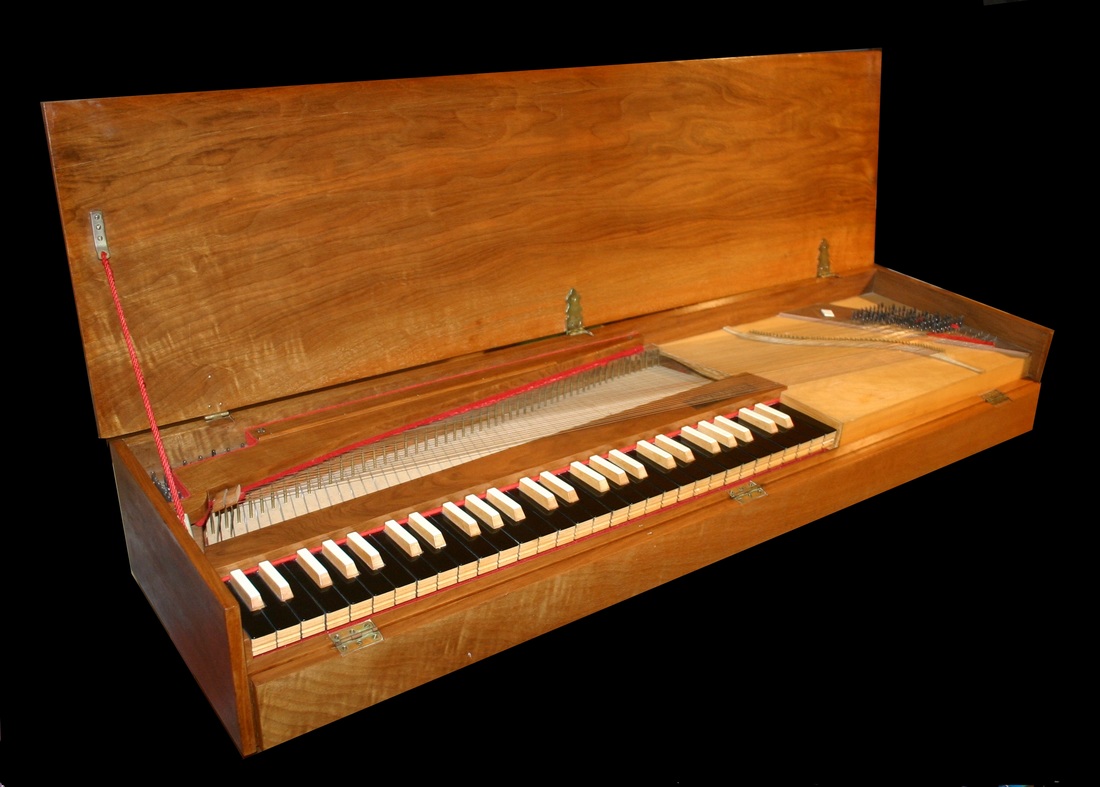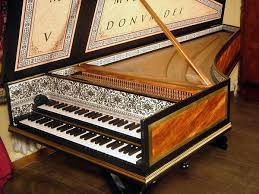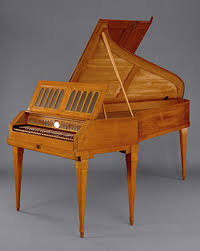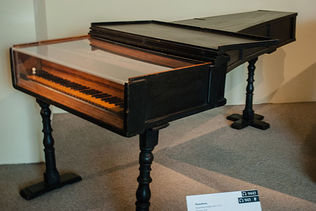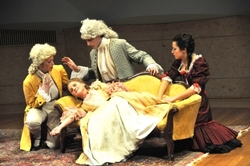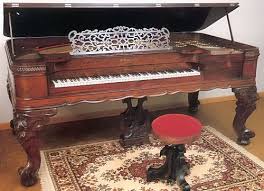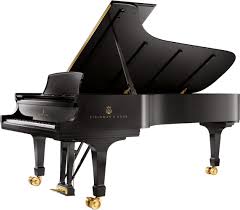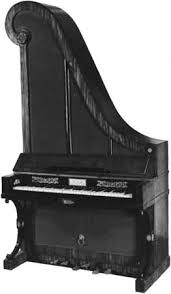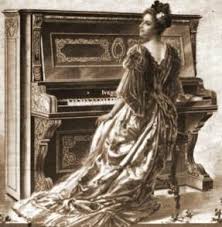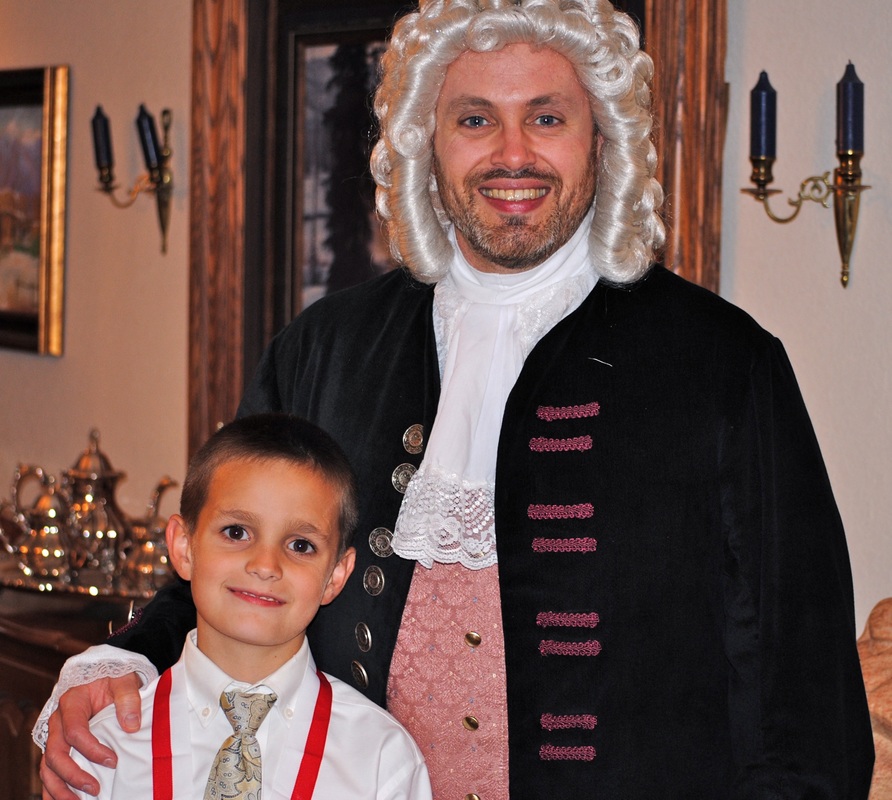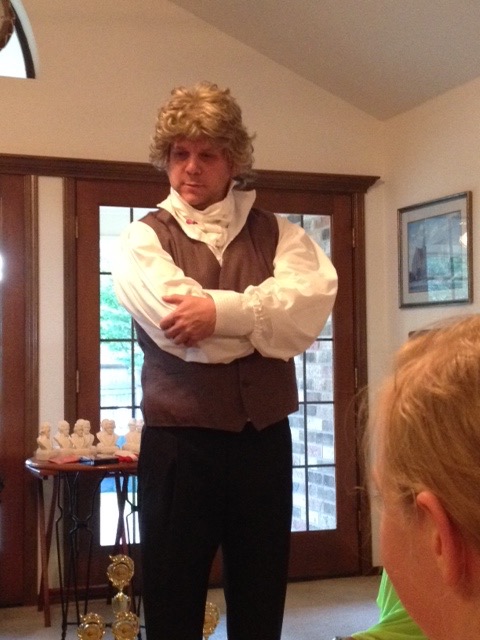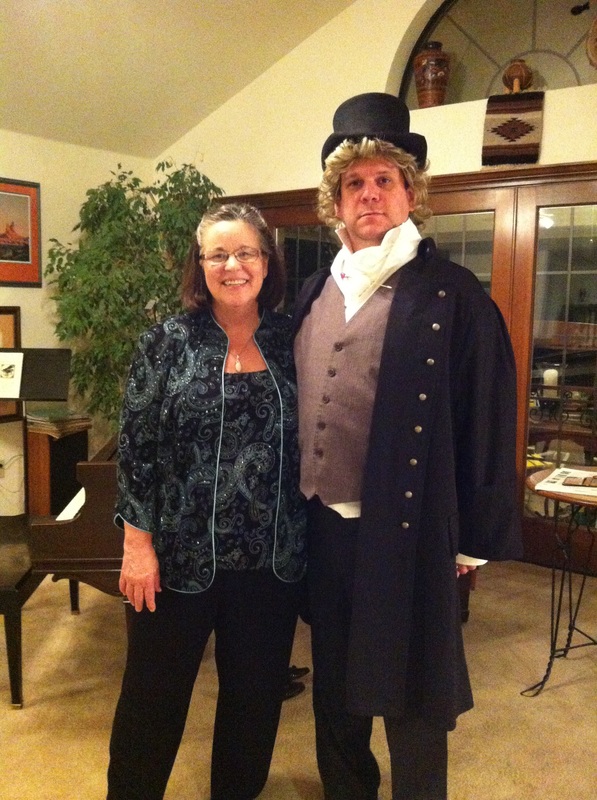2016-2017 Mystery Composer Contest
We are off and running!
Students received their first "clue" at the August Group Lessons. We discussed the list of composers I take the current year's Mystery Composer (M.C.) from, the list of former Mystery Composers and a description of the general historical periods of music. Additional clues are handed out at the October, December and February Group Lessons. The April Group Lesson is spent on the history and music of that year's Mystery Composer. As each Group Week is completed, I will post the clue in this section. See below for August's clues.
Rules of the contest are:
Prizes:
Happy Research!!
Students received their first "clue" at the August Group Lessons. We discussed the list of composers I take the current year's Mystery Composer (M.C.) from, the list of former Mystery Composers and a description of the general historical periods of music. Additional clues are handed out at the October, December and February Group Lessons. The April Group Lesson is spent on the history and music of that year's Mystery Composer. As each Group Week is completed, I will post the clue in this section. See below for August's clues.
Rules of the contest are:
- Students must do their own research. They may use the internet, the library, or books you have at home. (Early elementary students may have parental help at the computer. Parents, please do not do the work for students--let them figure out how to use the clues to search for their information needed. You may "guide" your student by asking them leading questions.)
- You must email the results of your research (no telephone conversations or texts, please) for I print the correspondence and place in your Group Notebook. In order for you to receive a correct answer you must include the following:
- Name of the Mystery Composer
- Dates of birth and death (unless still living)
- Why did you pick this particular composer? Which part of my clue did you use?
- If used, list any and all websites you searched.
- I will answer your email as soon as possible with either a "congratulations" or a "hmm.....this part is good but I need (fill in the blank)."
- There will be ties. Group lessons are held on 3 different days in the week; each group will be allowed the same amount of time for students to research and turn in the results of that research. I will say that the competition in the High School Group has been rather cutthroat in the last several years. The contest now is not for which level of prize to aim for but to see who can qualify for the grand prize in the shortest amount of time. This makes for very interesting and fun emails.
Prizes:
- Grand Prize: $20.00 Gift Certificate to Barnes and Noble
- Group Prize: $15.00 Gift Certificate to Barnes and Noble
- Honorable Mention: $10.00 Gift Certificate to Barnes and Noble
Happy Research!!
M.C. Contest WinnersWinners of the various levels of prizes will be posted on this website one week after Group Week. This will allow all students in all Groups (including those who missed Group) the same amount of time for research. Good Luck!
M.C. Winners (2016-2017). M.C. CluesAugust 2016Links to two of the clues are: List of Composers; Previous Mystery Composers.
Ages of Music
|
|
The Mozart Vienna Orchestra
|
Haydn's opera La Canterina
(The Diva) |
Romantic Period (1810 - 1910)
This era saw the perfection of the modern day piano. this instrument was enlarged and perfected in its action, pedals, frames, and sound boards. The piano now used large metal frames inside the wood casings. Concert grands were as large as nine feet long and able to produce a wide range of sound. Other pianos were square, thin and tall, or rectangular in order to fit into the homes of the now large middle class. Composing for, and playing, the organ came back in style with the improvements of wind supply and the ability to have huge, orchestral organs. Virtuoso playing, chromatic harmony, the um-pah-pah bass and idiomatic keyboard figures were the standard of the day. Leaving the courts (many "courts" were disappearing), music was performed in concert halls. Forms include program and character pieces, rhapsodies, fantasy sonatas and concertos, two-piano works, and etudes along with the ever evolving sonata, concertos, and variations.
20th Century/Contemporary/Modern (1900 - present)
The last century has seen a theme and variation on the keyboard instrument. Today we use the organ, piano, celesta, harpsichord, electronic keyboards, digital keyboards, even I-pads and I-phones and can perform on an instrument while being accompanied at the same time by that very same instrument. This is the age of experiments in harmony, tonality, and sonority. Various percussive touches, a return to motivic and polyphonic writing and complex meters are also used. Taped sounds can be used as well as "prepared" instruments. Music is performed in concert halls, churches, auditoriums, stadiums, arenas and even our smart phones. The musical theatre is important as are the scores of movies (think of Phantom of the Opera or the Harry Potter series). We can also hear music of any kind and age on the radio, television, recordings, computer and, once again, our smart phones. Forms used are those of the past as well as "chance" pieces and through composed.
October 2016
This year’s M.C. lived at a time when central Europe was going through a period of transition. After years of war, the remnants of the Holy Roman Empire had divided into small semi-self-governing principalities. The result was competing rivalries between these municipalities for identity and recognition. Political leadership of small city-states like Salzburg, Vienna, and Prague was in the hands of the aristocracy and their wealth would commission artists and musicians to amuse, inspire, and entertain. The music of the Renaissance and Baroque periods was transitioning toward more full-bodied compositions with complex instrumentation.
M.C.’s appearance has been described as a “remarkable small man, very thin and pale, with a profusion of fine, fair hair of which he was rather vain.” There was really nothing special about his appearance to give signs of his genius. He had large intense eyes; his facial complexion was pitted, a reminder of his childhood case of smallpox.
M.C. learned at a very early age to play harpsichord and violin when he listened, as a three-year old, to his seven-year old sister take lessons from their father. M.C. understood the lessons so well, his father began teaching the younger sibling. By five M.C. showed outstanding ability on harpsichord and the violin; he added viola and organ, then as a young adult fell in love with the new “pianoforte”.
Some words from M.C.:
“The music is not in the notes, but in the silence between.”
“Neither a lofty degree of intelligence nor imagination nor both together go to the making of genius. Love, love, love, that is the soul of genius.”
“People err who think my art comes easily to me. I assure you, dear friend, nobody has devoted so much time and thought to compositions as I. There is not a famous master whose music I have not industriously studied through many times.”
M.C.’s appearance has been described as a “remarkable small man, very thin and pale, with a profusion of fine, fair hair of which he was rather vain.” There was really nothing special about his appearance to give signs of his genius. He had large intense eyes; his facial complexion was pitted, a reminder of his childhood case of smallpox.
M.C. learned at a very early age to play harpsichord and violin when he listened, as a three-year old, to his seven-year old sister take lessons from their father. M.C. understood the lessons so well, his father began teaching the younger sibling. By five M.C. showed outstanding ability on harpsichord and the violin; he added viola and organ, then as a young adult fell in love with the new “pianoforte”.
Some words from M.C.:
“The music is not in the notes, but in the silence between.”
“Neither a lofty degree of intelligence nor imagination nor both together go to the making of genius. Love, love, love, that is the soul of genius.”
“People err who think my art comes easily to me. I assure you, dear friend, nobody has devoted so much time and thought to compositions as I. There is not a famous master whose music I have not industriously studied through many times.”
January 2017
Miserere, by Italian composer Gregorio Allegri (1582-1652), is a setting of Psalm 51 composed during the reign of Pope Urban VIII, probably during the 1630s, for use in the Sistine Chapel during matins as part of the exclusive Tenebrae service on Wednesday and Friday of Holy Week. It was the last of twelve misereres composed and chanted at the service since 1514, and the most popular. The Vatican wanted to preserve the music’s reputation for mystery and inaccessibility so it was forbidden to be transcribed and was only performed at those particular services. Writing it down or performing it elsewhere was punishable by excommunication.
At the age of 14, M.C. was in Rome during Holy Week. He went to the service on Wednesday; later that day, he wrote it down entirely from memory, returning to the Chapel that Friday to make minor corrections. Some time during his travels, he met the British historian Dr Charles Burney, who obtained the piece from him and took it to London, where it was published in 1771. M.C. was summoned to Rome, but instead of excommunicating the boy, the Pope showered him with praise for his feat of musical genius awarding him one of the highest honors anyone could receive from the church — Knight of the Golden Spur. M.C. wore the beautiful golden medallion with pride.
M.C.’s own music is at once easy and hard to listen to: easy, because of its grace, its never-ending melody, its clear and perfect organization; hard, because of its depth, its subtlety, its passion. It is strange to say of a composer who started writing at age six, and lived only thirty-six years, that he developed late, but that is the truth. Few of M.C.’s early works, elegant as they are, have the personality, concentration and richness that entered his music after 1781. With the exception of his symphonies, 1781 marks the period of M.C.’s maturity and virtually every work thereafter is a masterpiece.
In Vienna he began to write music of much greater depth, confidence, brilliance, and power. This music was not universally admired. There were those who found it pompous, too complicated, hard to follow. A violinist contemporary, Karl Ditters von Dittersdorf, wrote: “I have never yet met with any composer who had such an amazing wealth of ideas. I could almost wish he were not so lavish in using them. He leaves his hearer out of breath, for hardly has he grasped one beautiful thought than another of greater fascination dispels the first, and this goes on throughout, so that in the end it is impossible to retain any one of these beautiful melodies.”
At the age of 14, M.C. was in Rome during Holy Week. He went to the service on Wednesday; later that day, he wrote it down entirely from memory, returning to the Chapel that Friday to make minor corrections. Some time during his travels, he met the British historian Dr Charles Burney, who obtained the piece from him and took it to London, where it was published in 1771. M.C. was summoned to Rome, but instead of excommunicating the boy, the Pope showered him with praise for his feat of musical genius awarding him one of the highest honors anyone could receive from the church — Knight of the Golden Spur. M.C. wore the beautiful golden medallion with pride.
M.C.’s own music is at once easy and hard to listen to: easy, because of its grace, its never-ending melody, its clear and perfect organization; hard, because of its depth, its subtlety, its passion. It is strange to say of a composer who started writing at age six, and lived only thirty-six years, that he developed late, but that is the truth. Few of M.C.’s early works, elegant as they are, have the personality, concentration and richness that entered his music after 1781. With the exception of his symphonies, 1781 marks the period of M.C.’s maturity and virtually every work thereafter is a masterpiece.
In Vienna he began to write music of much greater depth, confidence, brilliance, and power. This music was not universally admired. There were those who found it pompous, too complicated, hard to follow. A violinist contemporary, Karl Ditters von Dittersdorf, wrote: “I have never yet met with any composer who had such an amazing wealth of ideas. I could almost wish he were not so lavish in using them. He leaves his hearer out of breath, for hardly has he grasped one beautiful thought than another of greater fascination dispels the first, and this goes on throughout, so that in the end it is impossible to retain any one of these beautiful melodies.”
February 2017
As a composer, M.C. was supreme in all forms of music--symphony, concerto, chamber, vocal, piano, choral--but had a special passion for opera. In 1764, M.C.'s father reported from London that his son "constantly has an opera running in his head." M.C. was eight years old at the time. Seven years later in Milan, M.C. recalled an entire opera by the respected composer Johann Hasse. M.C.'s craving for operas, particularly for composing them, obsessed him all his life. M.C.'s first opera to be performed was an opera buffa (comic opera) written when he was 12. M.C.'s last opera was written and performed the last year of his life, a Singspiel (literally "sing-play" meaning both sung and spoken dialogue, kind of like a modern musical).
M.C. could write down a complicated piece while thinking out another piece in his head; or he could think out a complete string quartet then write out the individual parts before making the full score; or he could read perfectly at sight any music placed before him; or he could hear a long piece of music for the first time and immediately write it out, note for note.
The year of his death, a tall gaunt stranger, wearing grey, called one day on M.C. and left an anonymous letter asking him to write a Requiem*. M.C., ill and depressed, was deeply worried by this unknown man who kept calling on him and demanding the Requiem. M.C. felt his end was near, and that he was composing his own Requiem. He was not to know that the strange man in grey had come from a nobleman who wanted to pass off M.C.'s composition as his own. Meanwhile the premier of M.C.'s last opera was set for September 30; he wrote the last notes for the opera on September 29. M.C. was sick and lived on medicine; he had had so many recent failures and disappointments that he had lost his natural confidence. However, the opera was a resounding success and has held its own in modern opera houses in the fierce competition for limited places in the repertory.
M.C. became sicker and sicker. In December he gave one of his pupils--Sussmayar--strict instructions about how to the the Requiem, as he was sure now he would never be able to do it himself. M.C.'s last act was to try and make the sound of the drums in his Requiem. His last breath was his music; then he died.
M.C.'s funeral was both simple and cheap. At the actual funeral there was only a small handful of family and friends. On that rainy winter day no one followed the coffin to the grave in Vienna's St. Marx cemetery. According to the practice at the time M.C.'s coffin was buried in a grave shared with four or five other souls. (Not as legend has it, a pauper's grave.) About 10-15 years later, this plot was dug up to make room for more burials. Again, according to the then current practice, the bones of all occupants were re-interred in a smaller space; consequently the site of M.C.'s grave was lost to history. The current monument and "grave" are the results of an educated guess.
So. Who is this year's M.C.?
********************************************************************************
*Requiem: A Requiem or Requiem Mass, also known as Mass for the dead, is a Mass in the Catholic Church offered for the repose of the soul using a particular form of the Roman Missal. It is frequently celebrated in the context of a funeral. Musical settings of the propers of the Requiem Mass are also called Requiems, such as the one mentioned above. The Mass and its settings draw their name from the introit of the liturgy which begins with the words "Requiem eternal dona is Domine"--"Grant them eternal rest, O Lord."
Many of the texts in the Requiem Mass have been set to music, including, but not limited to the Introit, Kyrie Eleison, Gradual, Dies Irae, Offertory, Sanctus, Agnus Dei, Pie Jesu, Libera Me, and In Paradisum. Over 2,000 Requiem compositions have been composed dating from the latter half of the 15th century to today. Some are short, some performed a cappella, and some are more suited for the concert hall than a funeral service.
M.C. could write down a complicated piece while thinking out another piece in his head; or he could think out a complete string quartet then write out the individual parts before making the full score; or he could read perfectly at sight any music placed before him; or he could hear a long piece of music for the first time and immediately write it out, note for note.
The year of his death, a tall gaunt stranger, wearing grey, called one day on M.C. and left an anonymous letter asking him to write a Requiem*. M.C., ill and depressed, was deeply worried by this unknown man who kept calling on him and demanding the Requiem. M.C. felt his end was near, and that he was composing his own Requiem. He was not to know that the strange man in grey had come from a nobleman who wanted to pass off M.C.'s composition as his own. Meanwhile the premier of M.C.'s last opera was set for September 30; he wrote the last notes for the opera on September 29. M.C. was sick and lived on medicine; he had had so many recent failures and disappointments that he had lost his natural confidence. However, the opera was a resounding success and has held its own in modern opera houses in the fierce competition for limited places in the repertory.
M.C. became sicker and sicker. In December he gave one of his pupils--Sussmayar--strict instructions about how to the the Requiem, as he was sure now he would never be able to do it himself. M.C.'s last act was to try and make the sound of the drums in his Requiem. His last breath was his music; then he died.
M.C.'s funeral was both simple and cheap. At the actual funeral there was only a small handful of family and friends. On that rainy winter day no one followed the coffin to the grave in Vienna's St. Marx cemetery. According to the practice at the time M.C.'s coffin was buried in a grave shared with four or five other souls. (Not as legend has it, a pauper's grave.) About 10-15 years later, this plot was dug up to make room for more burials. Again, according to the then current practice, the bones of all occupants were re-interred in a smaller space; consequently the site of M.C.'s grave was lost to history. The current monument and "grave" are the results of an educated guess.
So. Who is this year's M.C.?
********************************************************************************
*Requiem: A Requiem or Requiem Mass, also known as Mass for the dead, is a Mass in the Catholic Church offered for the repose of the soul using a particular form of the Roman Missal. It is frequently celebrated in the context of a funeral. Musical settings of the propers of the Requiem Mass are also called Requiems, such as the one mentioned above. The Mass and its settings draw their name from the introit of the liturgy which begins with the words "Requiem eternal dona is Domine"--"Grant them eternal rest, O Lord."
Many of the texts in the Requiem Mass have been set to music, including, but not limited to the Introit, Kyrie Eleison, Gradual, Dies Irae, Offertory, Sanctus, Agnus Dei, Pie Jesu, Libera Me, and In Paradisum. Over 2,000 Requiem compositions have been composed dating from the latter half of the 15th century to today. Some are short, some performed a cappella, and some are more suited for the concert hall than a funeral service.
|
|
Some Past M.C.s
Proudly powered by Weebly
